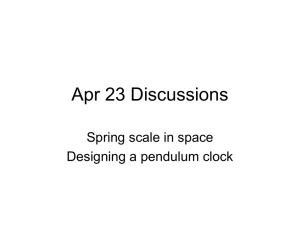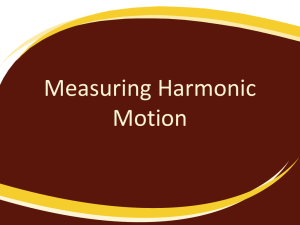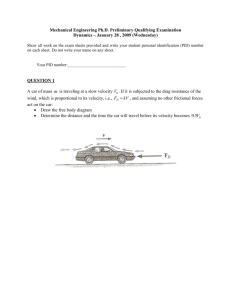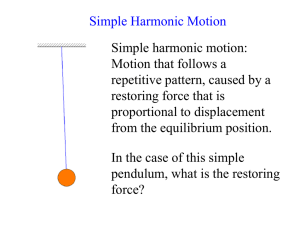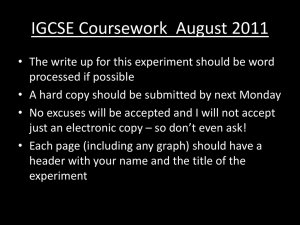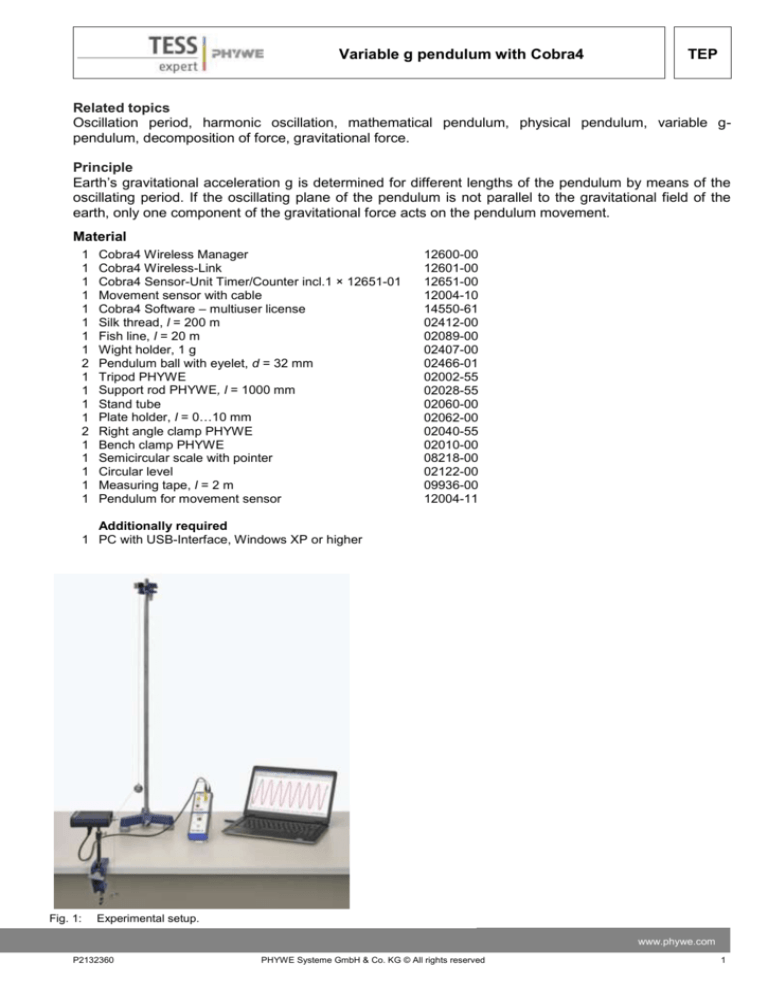
Variable g pendulum with Cobra4
TEP
Related topics
Oscillation period, harmonic oscillation, mathematical pendulum, physical pendulum, variable gpendulum, decomposition of force, gravitational force.
Principle
Earth’s gravitational acceleration g is determined for different lengths of the pendulum by means of the
oscillating period. If the oscillating plane of the pendulum is not parallel to the gravitational field of the
earth, only one component of the gravitational force acts on the pendulum movement.
Material
1
1
1
1
1
1
1
1
2
1
1
1
1
2
1
1
1
1
1
Cobra4 Wireless Manager
Cobra4 Wireless-Link
Cobra4 Sensor-Unit Timer/Counter incl.1 × 12651-01
Movement sensor with cable
Cobra4 Software – multiuser license
Silk thread, l = 200 m
Fish line, l = 20 m
Wight holder, 1 g
Pendulum ball with eyelet, d = 32 mm
Tripod PHYWE
Support rod PHYWE, l = 1000 mm
Stand tube
Plate holder, l = 0…10 mm
Right angle clamp PHYWE
Bench clamp PHYWE
Semicircular scale with pointer
Circular level
Measuring tape, l = 2 m
Pendulum for movement sensor
12600-00
12601-00
12651-00
12004-10
14550-61
02412-00
02089-00
02407-00
02466-01
02002-55
02028-55
02060-00
02062-00
02040-55
02010-00
08218-00
02122-00
09936-00
12004-11
Additionally required
1 PC with USB-Interface, Windows XP or higher
Fig. 1:
Experimental setup.
www.phywe.com
P2132360
PHYWE Systeme GmbH & Co. KG © All rights reserved
1
TEC
Variable g pendulum with Cobra4
Tasks
1. Determination of the oscillation period of a thread pendulum as a function of the pendulum length.
2. Determination of g.
3. Determination of the gravitational acceleration as a function of the inclination of the pendulum force.
Set-up and procedure
In accordance with Fig. 1 measure the oscillation period of the thread pendulum.
Perform the electrical connection of the movement
sensor to the Cobra4 Sensor unit Timer/Counter according to Fig. 2. The thread runs parallel and is
placed across the larger of the two cord grooves on
the movement sensor.
Fig. 6 shows the set-up for measurement with the variable g pendulum.
Connect the Cobra4 Wireless Manager to the USBinterface of the computer and plug the Cobra4 SensorUnit Timer/Counter on the Cobra4 Wireless-Link and
switch the link on. Start the “measure”-software and
open the “Variable g pendulum” experiment. (“Experiment” “Open experiment”). All pre-settings that are
necessary for measured value recording are now carried out except the axis diameter. To set this parameter double click on “Distance s1” and enter the right
value (Fig. 3). The axis diameter in the ”Rotation”
menu item is twice the distance from the pivot point of
the pendulum to the attachment point of the silk thread
that runs to the movement sensor. Set the pendulum in Fig. 2: Connection of the movement sensor to the Cobra4
Sensor Unit Timer Counter.
motion (small oscillation amplitude) and click on
in
the icon strip to start measurement.
After approximately 5 oscillations click on the ”Stop measurement” icon. You receive a characteristic
curve of the pendulum oscillation as shown in Fig. 4.
Fig. 3:
2
Setting of the axle diameter.
Fig. 4:
Typical pendulum oscillation.
PHYWE Systeme GmbH & Co. KG © All rights reserved
P2132360
Variable g pendulum with Cobra4
TEP
Remark:
Move the 1 g weight holder, which tautens the coupling thread between the pendulum ball and the
movement sensor, manually downward and then release it. This avoids lateral oscillations of the pendulum ball, which can lead to measurement errors.
Calculate the acceleration of gravity for various pendulum lengths, but constant pendulum mass.
Subsequently, keep the pendulum length constant but increase the pendulum mass by hanging the second sphere onto the eyelet of the first one; and then determine g. Determine the period duration with the
aid of the cursor lines, which can be freely moved and shifted onto the adjacent maxima or minima of the
oscillation curve (Fig. 5).
Fig. 5:
Typical measurement result.
Rebuild the experimental set-up according to Fig. 6. The oscillation plane is initially vertical. The round
level located on top of the movement sensor housing facilitates the exact adjustment. Determine g for
various deflection angles.
For identical initial deflection angles (e.g. approx. γ = 15°) determine g; in these measurements, however, the oscillation plane is not vertical but rather at an angle ϑ to the perpendicular. The following angles
are recommended for measurement: ϑ = 0°, 10°, 20°, 40°, 60°, 80°.
Fig. 6:
Experimental set-up for the variable g-pendulum.
www.phywe.com
P2132360
PHYWE Systeme GmbH & Co. KG © All rights reserved
3
TEC
Variable g pendulum with Cobra4
Theory and evaluation
As a good approximation, the pendulum used here can be treated as a mathematical (simple) pendulum
having a length l. However, depending on the position of the pendulum weight, the length l deviates
more or less from the geometric pendulum length L, which is measured between the pivot point and the
centre of the moveable weight (compare Task 3). A retracting force acts on the pendulum mass m at a
deflection equal to the angle ϑ
𝐹(𝛾) = −𝑚𝑔 ∙ sin 𝛾 ≈ −𝑚𝑔𝛾
for small angle 𝛾
If one ensures that the amplitudes remain sufficiently small while experimenting, the movement can be
described by the following differential equation:
𝑙∙
𝑑2 𝛾
= −𝑔𝛾
𝑑𝑡 2
The following is obtained as the solution:
𝑔
𝛾 = 𝛾0 ∙ sin (√ ∙ 𝑡)
𝑙
(1)
This is a harmonic oscillation having the amplitude γ0 and the oscillation period T.
𝑇 = 2𝜋√
(1)
𝑙
𝑔
If one rotates the oscillation plane around the angle ϑ with respect to the vertical plane, the components
of the acceleration of gravity g(ϑ) which are effective in its oscillation plane are reduced to
g(ϑ) = g・cosϑ and the following is obtained for the oscillation period:
(2)
𝑙
𝑇(𝜗) = 2𝜋√
𝑔 ∙ cos 𝜗
Table 1 contains exemplary measurements for different pendulum lengths; whereas the mass of the
sphere is kept constant. An increase in the pendulum mass for constant pendulum lenghts supplies an
identical acceleration of gravity value. In one sample measurement, the pendulum length is l = 0.9 m:
Number of spheres
1
2
g [m/s²]
9.75
9.76
l [m]
0.84
0.69
0.43
g [m/s²]
9.75
9.61
9.86
Table 1
4
PHYWE Systeme GmbH & Co. KG © All rights reserved
P2132360
TEP
Variable g pendulum with Cobra4
The familiar equation (1) for the calculation of the period of a thread pendulum
𝑙
𝑇 = 2𝜋 ∙ √
𝑔
applies strictly only for the borderline case of infinitely small oscillation amplitudes. For greater amplitudes this equation must be replaced by an expression such as
𝑙
1
𝛾 9
𝛾
𝑇 = 2𝜋√ (1 + sin ² + sin4 + ⋯ )
𝑔
4
2 64
2
Thus, the oscillation period increases with increasing angle γ.
If
𝛾=
4𝜋² ∙ 𝑙
𝑇²
(3)
is used to calculate g, this results in an acceleration of gravity that becomes continually smaller. The
measured values in Table 2 exhibit this exact behaviour. However, Table 2 also shows that angles
smaller than 20° can be considered as being sufficiently small to satisfy the equation (3).
Maximal deflection [°]
5
10
20
45
90
approx. 180
g [m/s²]
9.87
9.82
9.82
8.67
7.07
3.95
Table 2
For a pendulum with vertical oscillation plane (Fig. 7), the tangential component of the weight mg sin γ is
the restoring force of the oscillation. If the oscillation plane is at an angle ϑ to the perpendicular (Fig. 8),
only the force component mg sin γ cos ϑ is effective. Therefore, for the oscillation period T it follows that
𝑙
𝑇 = 2𝜋√
𝑔 ∙ cos 𝜗
𝜗set [°]
0
10
20
40
60
80
g [m/s²]
9.87
9.69
9.34
7.74
5.22
2.07
𝜗calculated [°]
0
9.11
17.89
37.93
57.85
77.81
Table 3
www.phywe.com
P2132360
PHYWE Systeme GmbH & Co. KG © All rights reserved
5
TEC
Variable g pendulum with Cobra4
In the framework provided by the measuring accuracy, the measurement data in Table 3 confirm this
correlation.
Since with a variable g pendulum, the acceleration of gravity acting on the pendulum is virtually changeable, the experiment can also be performed in order to become an idea of how rapidly a vertical pendulum would oscillate on the moon or on Mars. On the moon the gravitational attraction is approximately
16.6% of that on the earth; this corresponds to an angle ϑ = 0.5°. The gravitational attraction on Mars
can be simulated by an angular setting of ϑ = 69°, since the acceleration of gravity only reaches 38% of
that on the earth.
In the evaluation of the oscillation periods the pendulum rod was considered massless. The pendulum
length l was the distance of the centre of the supported mass from the centre of the rotational axis. If the
mass of the pendulum rod is considered, this has the consequence that the centre of mass moves closer
to the rotational axis, i.e. l becomes shorter. If an increase in measuring accuracy is desired, this effect
must be taken into consideration.
Remarks
The weight hanging directly on the rotational axis of the movement sensor should not exceed 100 g and
should also be only briefly attached to the movement sensor to avoid bearing damage.
In extremely short oscillation periods, signal transients or deformations can occur. These can be reduced
if the sampling rate is changed. In any case, error-free recorded intervals can be selected from the
measuring signal after completion of the measurements.
Sickle-shaped deformation of the oscillations are due to slippage of the thread across the cord groove on
the movement sensor. This is avoided if the thread is wound around the cord groove once.
Since the movement recording is not performed without contact, slight damping of the measured oscillations does occur. In the calculation of alpha (t) differences of small sizes must be formed and divided by
short time intervals. This results increased noise in the alpha (t) curve compared to the omega (t) curve.
Angular velocities that are too small can no longer be registered by the movement sensor and are displayed as a reference line.
Instead of the movement sensor, the compact, fork-type light barrier (11207-20) can be used. However,
in this case the experiment with the variable g pendulum cannot be performed.
Fig. 7:
6
Consideration of the standard pendulum.
Fig. 8:
Analysis of the force for a pendulum with an inclined oscillation plane (g pendulum).
PHYWE Systeme GmbH & Co. KG © All rights reserved
P2132360



